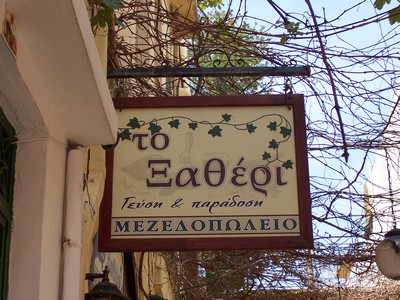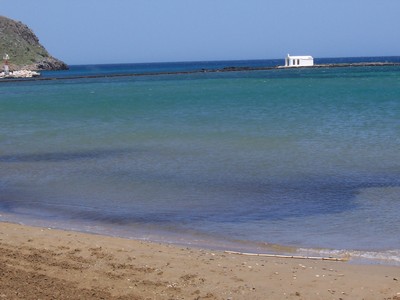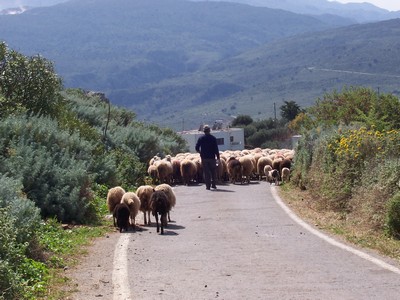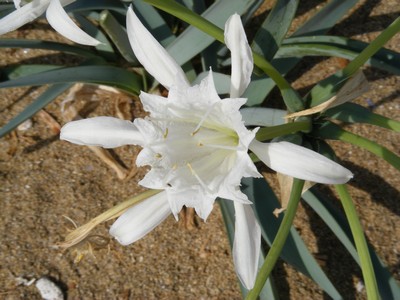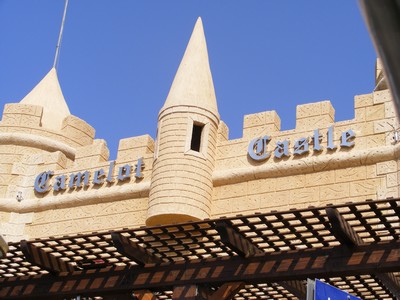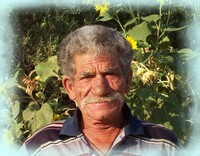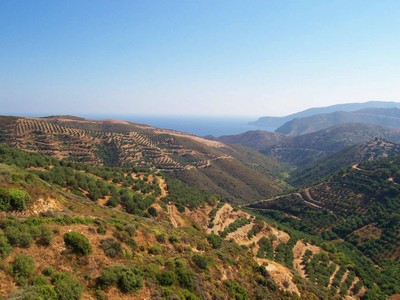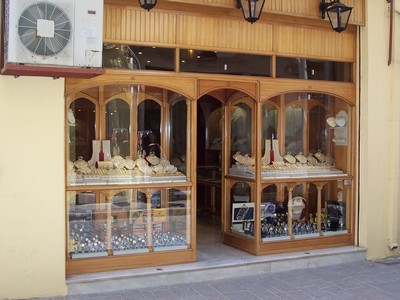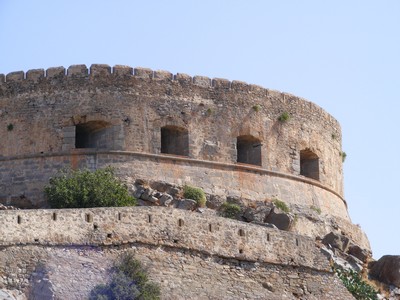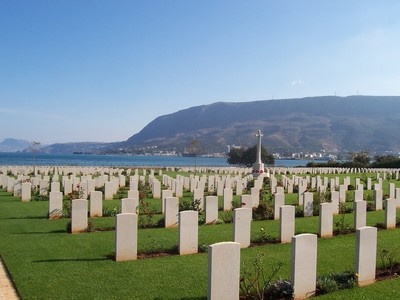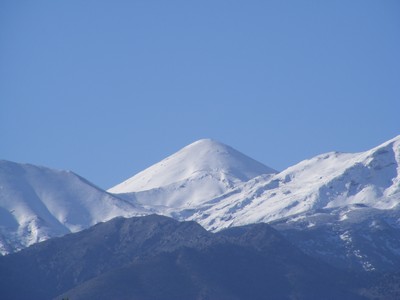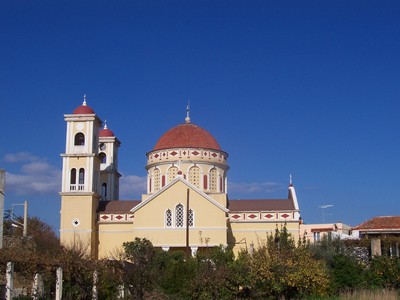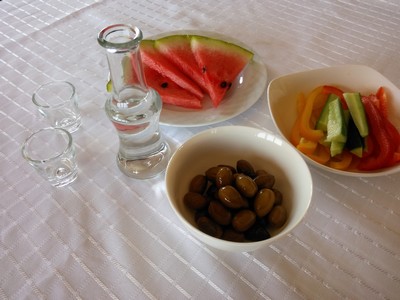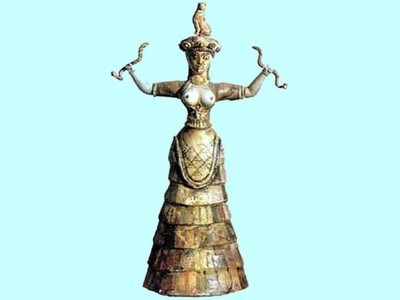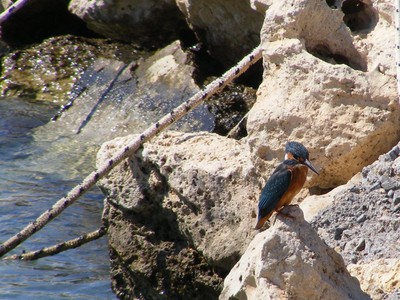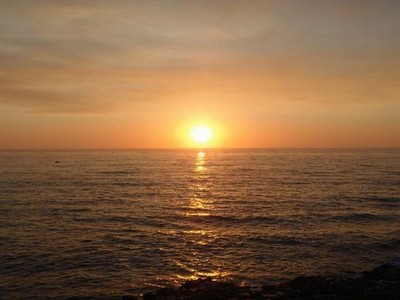Crazy about the Greek island of Crete!
Crete Easter
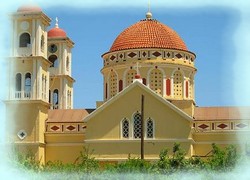
Easter in Crete and indeed Greece is the most important celebration of the year, outshining Christmas by far. This year, 2009 the Greek Orthodox Easter Sunday is celebrated on April 19th, whereas in the western catholic and protestant churches Easter is celebrated a week earlier.
The Greek Orthodox calendar for Easter is different to the western churches because the Eastern Orthodox Church uses the modified Julian calendar, rather than the Gregorian calendar.
Crete Easter Holy Week
The austere fasting during Lent finally comes to an end at Easter and is a time of feasting. In Greece and Crete Easter is known by the word Pascha.
Each day during Holy Week of Greek Easter church services are held.
Crete Easter Feast of Lazurus
The day before Palm Sunday is the feast day of Lazarus. In the Bible Lazurus was said to have risen from the dead. His resurrection is commemorated at special church services on this day. This day is also celebrated as symbolic of the beginning spring.
Traditionally on this day children would dress as Lazarus wearing white sheets and adorned with daisy chains around their necks and in their hair. This, no doubt has its roots in pre Christian Pagan times.
Crete Easter Palm Sunday
The start of Holy Week or Great Week is Palm Sunday. At church services celebrating Palm Sunday, members of the congregation are given a palm leaf, commemorating Christ's entrance into Jerusalem, when he was praised with people waving palm leaves.
These palm leaves are fashioned into a cross and kept within the home until the following year. There is abstinence of meat and dairy products on this day and traditionally fish is eaten.
Crete Easter Great Monday – Holy Monday
From the Monday before Easter every day is named a “Great” day. Easter in Crete sees each evening of Great Monday, Tuesday, and Wednesday, readings and hymns in church anticipating the Passion of Christ.
Crete Easter Great Tuesday – Holy Tuesday
On this day it is traditional for women to prepare and bake sweet Easter biscuits named koulourakia.
Greek Easter Biscuits
Here's a traditional recipe for Greek Easter Biscuits:
3 egg yolks
3 cups of butter
2 cups of sugar
Grated zest of one orange
1 cup orange juice
1 teaspoon Vanilla extract
3 tablespoons brandy
1.5 Kilo of strong flour
1 teaspoon baking powder
Beat the butter and sugar, add the egg yolks, orange rind, vanilla extract, orange juice and brandy. Add the flour gradually and knead until a soft, elastic dough is formed.
Break off small pieces and shape them into 'S' shapes, circles, rings and coils. Place them on an oiled baking tin. Brush them with beaten egg yolk. Bake in a moderate oven for about twenty minutes until golden brown. Allow to cool on a cooling tray before eating.
Crete Easter Great Wednesday – Holy Wednesday
Celebrating Easter in Crete you will see on Great Wednesday the faithful being anointed with holy oil or being blessed with a sprig of oregano. This is believed to cleanse, renew and strengthen both spiritually and physically.
Crete Easter Great Thursday – Holy Thursday
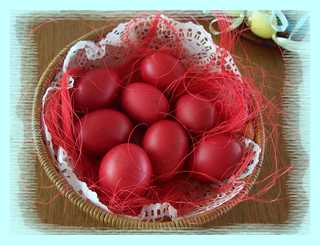 RED EGGS
RED EGGSOn Great Thursday morning women begin the task of dyeing eggs red. The red colour is said to symbolise Christ's blood. The red eggs are hard boiled eggs and traditionally were dyed with beetroot or onion skins in vinegar. Nowadays there are packets of prepared dye to colour the eggs.
The red eggs are kept whole and put into baskets or baked into sweetened bread loaves for use on Easter Sunday. This special Easter bread named Tsoureki is flavoured with almonds, anise, mastic or orange zest. The bread is shaped into ornate plaits and the red eggs are placed in them before baking.
It is on Easter Sunday when the red eggs are cracked against each other by family members and friends. The owner of the last un-cracked egg is believed to be in for some very good luck over the coming year.
In the morning of Holy Thursday a church service is held and communion offered.
In the evening of Holy Thursday the Service of Holy Passion is held. This is when he Twelve Lessons of the Gospel are read by the priest. This is a very long church service. After the first six Lessons are read, a cross with a carved statue of Christ is brought out and placed in front of the altar. With this symbol of Christ’s crucifixion, the next six Lessons are read.
Crete Easter Great Friday – Good Friday
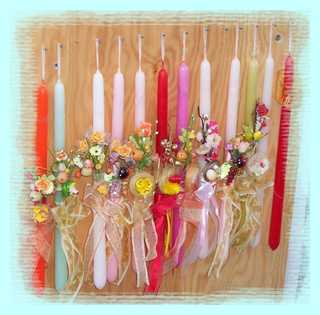 EASTER CANDLES
EASTER CANDLESOn Good Friday (Megali Paraskevi) most shops and businesses are closed. It is a solemn day and commemorates the crucifixion of Christ.
There are church services all day and women and girls decorate their church’s Epitaphios (the tomb of Christ) with fresh flowers. This is a labour of love and the result is a fragrant and beautiful sight.
Placed in the centre of the Epitaphios is a special elaborately embroidered cloth with the image of Christ upon it. This is symbolic of the dead body of Christ.
Many people buy ornately decorated Easter candles to take with them to the evening church service.
On Good Friday evening mourning continues for Christ in the tomb and women sing mournful dirges. The candlelight Epitaphios procession takes place with the priest heading the procession. Traditionally the young men who were about to commence their national military service would be given the honour of carrying the Epitaphios.
The solemn procession makes its way out of the church through the village to the cemetery and back with priests and altar boys carrying gold crosses and Icons. The congregation follows, holding lit candles. The Church bells peal slow, deep funeral tones.
After the procession returns to the church, the faithful will walk past and stoop under the Epitaphios and kiss the cloth containing the image of Christ.
Crete Easter Great Saturday – Holy Saturday
Late on Holy Saturday evening, the Easter Resurrection Service begins culminating at the stroke of midnight. The Church is plunged into darkness as the priest comes forward to the congregation with a single candle lit from the Eternal Flame carried carefully and un-extinguished from Jerusalem.
The priest announces ‘Christos Anesti’ - ‘Christ is risen’. From the flame of the priests candle the front rows of the congregation have their Easter candles ignited. They in turn pass the flame back to others until each member of the congregation has a lit candle and the church is aglow with candlelight – quite a magical sight!.
The noise of deafening fire crackers, fireworks, church bells and boisterous children and youths fill the air. Young people will light their bonfires and burn an effigy of Judas, the apostle who betrayed Jesus Christ.
After everyone has exchanged handshakes, kisses and Easter greetings the crowds soon disperse as everyone is hell bent on transferring their lit candle safely home.
On arrival home, with the flame from their candle householders will mark a sooty cross three times above their doorway. This ensures blessings on the home and good luck throughout the coming year.
Finally on Holy Saturday people can happily break their fasts. Traditionally a rice soup flavoured with lemon and lamb's offal is served. This is named Mageritsa Soup. The Easter biscuits are also consumed.
Crete Easter Great Sunday – Easter Sunday
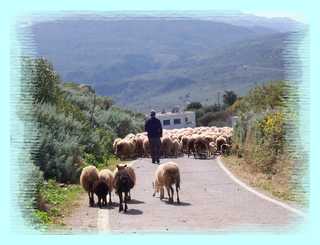 EASTER IN CRETE
EASTER IN CRETEOn Easter Sunday, after the Easter Service which celebrates the Risen Lord, families will gather to prepare a great feast.
The main ingredient of the feast is slow spit roasted lamb. The air is thick with the smell of delicious roasting barbequed meat as each family cooks their feast in the open air. The men are responsible for hand turning the lamb, which can take 6 hours to cook.
Easter biscuits will be eaten, wine drunk and cracking the red eggs will take place. This is a joyful and special family time.
No Crete Easter would be complete with traditional Cretan music, dancing and drinking of Tsikoudia (Raki). The festivities last all day and late into the night.
Crete Easter Easter Monday
Celebrations continue on Easter Monday as this is a national holiday.
Want to discover even more of what Crete has to offer?
Explore hidden gems, must-visit spots, and insider tips below!
Just Some of the Reasons We Love Crete
Did you love this page? Please share it with your friends!
© Copyright All Original Content 2006 - 2025 Completely-Crete.com. All
Rights Reserved. Reproduction in whole or in part without permission is
not permitted.
Click here to learn about developing your own money-generating website
from Solo Build It! - even with little or no web experience!
